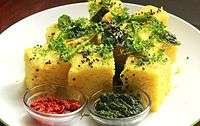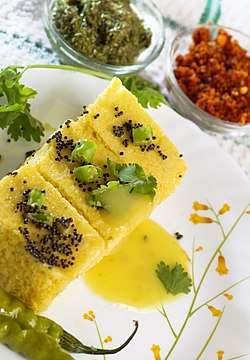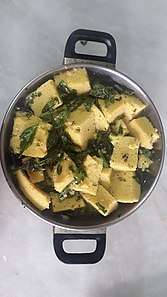Dhokla
Dhokla is a vegetarian culinary dish that is found mainly in the Indian state of Gujarat and parts of adjacent states.[1] It is made with a fermented batter derived from rice and split chickpeas.[2] Dhokla can be eaten for breakfast, as a main course, as a side dish, or as a snack. Dhokla is very similar to Khaman, however Dhokla is made of batter derived from rice gram and is white in color, whereas Khaman is typically made from Chickpeas gram and looks yellow in color. Khaman has become widely popular outside Gujarat but is misunderstood or incorrectly known as Dhokla.
 | |
| Alternative names | Dhokra |
|---|---|
| Course | Breakfast, side dish, main course |
| Place of origin | India |
| Region or state | Gujarat, Maharashtra |
| Serving temperature | room temp |
| Main ingredients | Besan (chickpea flour) and rice flour |
| Variations | Khaman |
History
Dukkia, a pulse-based precursor of the dhokla, is mentioned in a Jain text dated to 1066 CE. The earliest extant work to mention the word "dhokla" is the Gujarati Varanaka Samuchaya (1520 CE).[3]
Preparation
Rice and split chickpeas (chana dal), in a particular ratio (to achieve the desired texture and taste) are soaked overnight. The mixture is ground, and the paste is fermented for four to five hours or overnight. This is spiced by adding chili pepper, Coriander, ginger and baking soda.
The fermented batter is then steamed for about 15 minutes on a flat dish and cut into pieces. These chopped pieces are seasoned in hot oil with mustard seeds. Asafoetida and chopped green chillies can also be fried and, sometimes, an equal amount of water. The pieces are then removed from dish. Sometimes it is also fried in hot oil with cumin seeds.
It is usually served with deep fried chillies and chutney made from coriander. It is garnished with coriander and often with grated coconut.[4]
Another method is to steam the fermented batter for 10 to 15 minutes on plates placed inside a container that does not allow steam to escape. To avoid steam water falling on the batter during preparation, a cloth may be placed inside the container. The plates are not directly placed on the base, or the batter will burn, so a small stand is used. When the batter is steamed properly, the plates are taken out of the container and then served with raw oil poured over the dhokla, or used as dip. Other ingredients like curd, tomato sauce, garlic paste, or coriander paste may be used in serving, however none of these are traditionally eaten with dhokla.[4]
Types of Dhokla

There are different kinds of dhokla prepared with different ingredients and ratios of chickpeas. Some of the popular kinds of dhoklas are:
- Khatta dhokla
- Rasia dhokla
- Moong dal dhokla
- Khandavi dhokla
- Cheese dhokla
- Toor dal dhokla
- Sandwich dhokla
 Dhokla made in oven
Dhokla made in oven - Rava dhokla
- Mixed dal dhokla
- Green peas dhokla
- Meetha dhokla
- Besan dhokla
- Khaman dhokla
Khaman is a similar gram flour-based food. Whereas dhokla is made with rice and chickpeas, khaman is made from chickpeas only. It is generally lighter in color and softer than dhokla. To make dhokla, a small proportion of baking soda is added while to make khaman more baking soda is added to make it more fluffy, spongy and porous.
Idada is another variety of dhokla, which is made by using different lentils like black grams, also known as urad dal, instead of chickpeas. Dhokla is very commonly used as a breakfast or as a snack in western parts of India including Madhya Pradesh, though nowadays it's available in every Indian state. It is an easy to cook and easy to digest snack.
See also
| Wikibooks Cookbook has a recipe/module on |
References
- Reddy, N. R. (6 February 2018). Legume Based Fermented Foods. CRC Press. ISBN 9781351090902 – via Google Books.
- Redhead, J. F. (1989). Utilization of tropical foods. Food & Agriculture Org. p. 26. ISBN 978-92-5-102774-5.
- K. T. Achaya (1994). Indian food: a historical companion. Oxford University Press. p. 134.
- "Khaman Dhokla Recipe". Archived from the original on 22 Feb 2017. Retrieved 2 Feb 2020.


